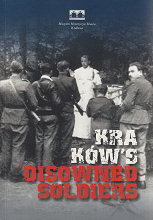
Kraków's disowned soldiers (előszó)
The temporary exhibition entitled Kraków's Disowned Soldiers is presented at a special venue on the city's historical map – the museum at Oskar Schindler's former "Emalia" factory, and this location is by no means accidental. On the contrary, with this event the Historical Museum of the City of Kraków lends credence to the part of its mission statement stipulating the devotion of a series of temporary shows to certain themes from the history of the city that have only been outlined at the permanent exhibition Kraków under Nazi Occupation 1939–1945.
It is not possible to understand the choices made and attitudes adopted by the Disowned Soldiers in detachment from the history of Poland during World War II, which is presented at the permanent exhibition for the visitors to explore and experience.
Confident about the support it was to receive from its allies, in 1939 Poland resolved to defend its autonomy and frontiers from the hostile attempts of not only Nazi Germany, but also – as it turned out shortly after – the Union of Soviet Socialist Republics (USSR). In May 1945 Germany was defeated, and yet Poland, however militant and aggrieved during the war, did not return to independence. Its territory found itself controlled by the other of the two aggressors of 1939 – the USSR, whose Red Army brawled its way through Poland like it had been one of its conquered territories.
Kraków's Disowned Soldiers is an exhibition that is special for a number of reasons. It is the first event in the programme of temporary shows presented at Oskar Schindler's Enamel Factory, a branch of the Historical Museum of the City of Krakow, that deals with the theme of the anti-Communist underground whose activists fought for Poland's independence after World War II.
We present the stories of 14 individuals known by their names who have remained in the memory of their relatives and have seldom been commemorated in an institutionalized form; in many cases the memory of their deeds is receding. Our mission as museum professionals is to learn as much as we possibly can about these individuals, save them from being forgotten, and cherish their memory, since their stories prove beyond doubt that they were worthy of respect despite all efforts made to bring them into disrepute.
The exhibition concentrates on one of the all-important periods in the contemporary history of Poland which is virtually unknown to general public in the world and which has only recently been examined in greater detail, popularized and introduced into collective memory in Poland.
It was not until 2011 that Polish parliament passed a law to establish Disowned Soldiers Remembrance Day, which has since been officially honoured on 1 March. The commemorative events are organized by central and local governments as well as ordinary Poles who have a heartfelt need to engage; that attitude is particularly evident in Kraków. The memory of the Disowned Soldiers was not condemned by Polish society but by the Communist authorities imposed upon Poland, who spent laborious decades on distorting history and erasing the memory of the people for whom independent Poland was the utmost priority. These people had not hesitated to fight for independence against the Third Reich and the Soviet Union sacrificing everything they had, including their own lives.
My profound thanks go to all institutions, in particular the branches of the Institute of National Remembrance in Warsaw and Kraków, the Museum of the South Poland Province of the Society of Jesus in Stara Wieś, the Home Army Museum in Kraków, the Archaeological Museum in Kraków, the Museum of Polish Armed Forces in Warsaw, the Historical Museum of the Capital City of Warsaw, Stanisław Fischer Museum in Bochnia, Borderlands Museum in Lubaczów and St Kinga of Poland Primary School in Maciejowa, and individuals who contributed to this exhibition by lending exhibits and devoting their time to the project. I am particularly grateful to the project team at the Historical Museum of the City of Kraków, namely curator and project manager Grzegorz Jeżowski; Marcin Baran, the editor of texts for the catalogue and the exhibition; deputy project manager Bartłomiej Nuckowski; and Anna Mokrzycka-Wagner and Jakub Wagner, the designers of the exhibition. I also wish to thank Wacław Sawicz for designing the catalogue and other promotional publications accompanying the exhibition, Joanna Rościszewska for conservator's supervision over the exhibition, Marta Śmietana for the promotion of the event, Piotr Cieślik for preparing the multimedia, and trainee Urszula Sobczyk.
Michał Niezabitowski
Director of the Historical Museum of the City of Kraków